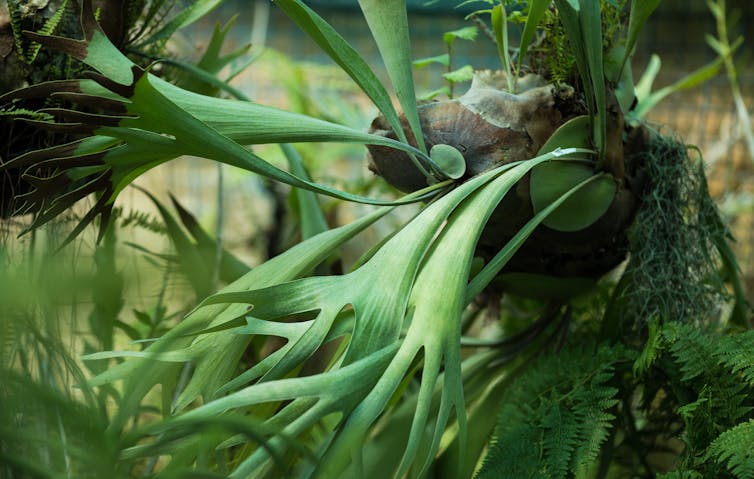
Shutterstock/Florist_Yana
Kevin Burns, Te Herenga Waka — Victoria University of WellingtonSocial colonies are nothing new in the animal kingdom. We know bees, ants and termites live in large colonies, divide labour and co-operate to take care of offspring produced by a single queen.
This behaviour, known as eusociality, has evolved independently in insects, crustaceans (certain species of shrimp) and even some mammals (naked mole rats), but it has never been observed in plants. This suggested plants were somehow less complex than animals.
Our study, published this week, turns our understanding of the evolution of biological complexity on its head. It documents the life history of a remarkable species of fern that grows in the tops of rainforest trees on Lord Howe Island, a small volcanic island in the north Tasman Sea.
Rather than growing as individual ferns in the treetops, the staghorn fern (Platycerium bifurcatum) lives in colonies, in an adaptation to its harsh habitat high above the water and nutrients stored in the soil below.
Individuals differ markedly in size, shape and texture. But they always grow side-by-side within colonies, fitting together like puzzle pieces to form a bucket-like store of water and nutrients available to all colony members.
Many individuals forgo reproduction and instead focus on capturing or storing water to the benefit of other colony members.
Read more:
We found the genes that allowed plants to colonise land 500 million years ago
Life in the tree tops
Staghorn ferns belong to a group of tree-dwelling plants known as epiphytes. Tree canopies are a challenging environment for plants to grow. Without access to soil, epiphytes are regularly exposed to severe water and nutrient stress.
Epiphytes have evolved several ways to mediate the lack of access to water and nutrients. Bromeliads grow cup-shaped leaves, while orchids have specialised root tissues. But staghorn ferns have developed a colony lifestyle to overcome the problem.

Author provided
Staghorn ferns can be bought at many garden stores and will grow like any other pot plant. But in the wild on Lord Howe Island, we discovered individual plants collaborate, specialising in different tasks in the construction of the communal water and nutrient store, often at the cost of their own reproduction — just like social insects.
This radically changes our understanding of biological complexity. It suggests major evolutionary transitions towards eusociality can occur in both plants and animals. Plants and beehives aren’t as different as they might seem.
For decades, scientists interested in eusociality argued for a strict definition — many felt the term should be reserved for only a select group of highly co-operative insects.
This perspective led to widespread scepticism about its occurrence in the natural world. Perhaps this is why it was overlooked for so long in one of horticulture’s most popular pot plants.
Evolution of biological complexity
Four billion years ago, life began as simple, self-replicating molecules. Today’s diversity arose from these simple origins towards increasingly complex organisms.
Evolutionary biologists think that biological complexity developed in abrupt, major evolutionary transitions, rather than slow and continuous changes. Such transitions occur when independent entities begin to collaborate, forming new, more complex life forms — such as, for example, when single-celled organisms evolved into multi-cellular organisms.

Shutterstock/Lebendkulturen.de
Another example is the transition from unspecialised bacterial (prokaryotic) cells to cells with an enclosed nucleus and specialised organelles that perform particular functions, known as eukaryotic cells.
Co-operation underpins the evolutionary origins of organelles — they likely evolved from free-living ancestors that gave up their independence to live safely within the walls of another cell.
Read more:
The social animals that are inspiring new behaviours for robot swarms
There are eight commonly recognised major evolutionary transitions — and eusociality is the most recent. Eusocial animals differ from others in three fundamental ways:
- they live in colonies comprised of different generations of adults
- they subdivide labour into reproductive and non-reproductive groups
- they care for offspring co-operatively.
Our observations over the past two years on Lord Howe Island found staghorn ferns meet these criteria.
In highly eusocial species, caste membership is permanent and unchanging. But in primitively eusocial species, individuals can alter their behaviour to suit many roles required by the colony. Staghorn ferns probably fit under the latter category.
Our ongoing research will determine the staghorn’s position along this continuum of eusociality. But, for now, we know plants and animals share a similar evolutionary pathway towards greater biological complexity.![]()
Kevin Burns, Professor, Te Herenga Waka — Victoria University of Wellington
This article is republished from The Conversation under a Creative Commons license. Read the original article.

